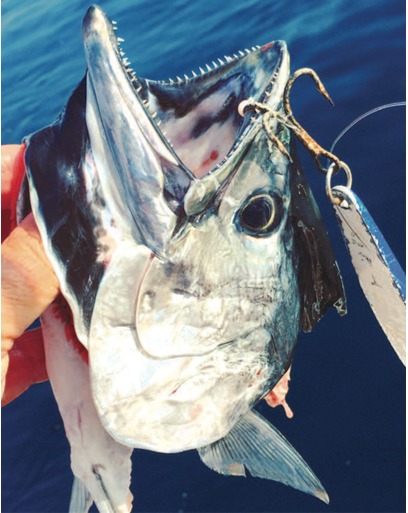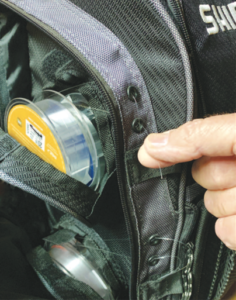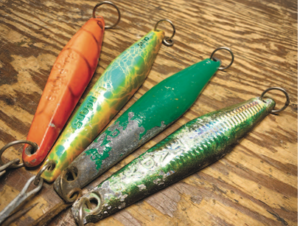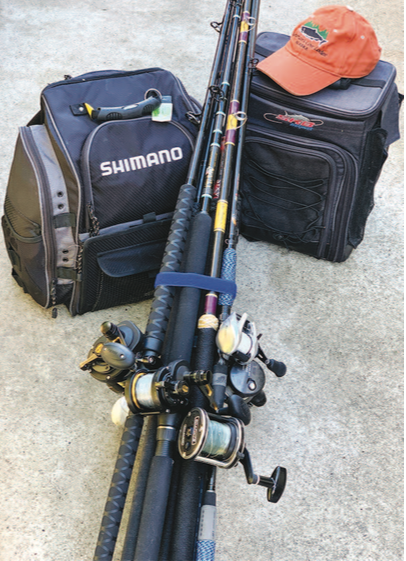
BY JON DICKENS
You’re at the dock waiting to board the party boat, still 45 minutes until departure. Out of boredom, you do a quick scan of your fellow anglers to see what kind of tackle they have with them and see if by comparison you’re geared up properly. You also play the talent game — who looks like they can fish and who doesn’t. Sometimes it’s obvious, sometimes not. Anyone can buy good tackle, but do they really know how to use it?
Look, there’s a guy with a trout rod, a $5 tackle box, nail clippers on a lanyard around his neck and a sack lunch. Hmmm. Guess that’s a beginner. Then there’s another guy with two rods and a little plastic bag holding his tackle. Another beginner? Look closer. This guy has deckhand-style custom wrapped rods with old-school Newell reels. And he’s wearing deck boots that have so many layers of blood and scales on them, that if they were dragged behind the boat they’d create their own chum slick. That guy no doubt has talent and the kind of guy you want to fish next to. That plastic tackle bag may not have much in it, but you can bet it’s the right stuff and all that’s needed for him to be successful.
At the opposite end of the spectrum, there’s a guy parked next to the railing that looks like he’s going on a 7-day long range trip. He’s carrying a quiver of eight rods, a rolling wooden tackle box plastered with decals of every party boat within 100 miles, plus another tackle bag balanced on top of it, a backpack slung over his shoulder and a half-chewed stogie between his teeth. Whoa! Somewhere in between all the above characters is probably where you want to be. Like many of you though, I’m also guilty of bringing too much tackle with me. If you looked in my garage you’d say I was a tackle junkie. The old adage, “I’d rather have it and not need it, than need it and not have it” is always lurking in the back of my mind. It’s also probably why my back sometimes hurts after a day of fishing. It’s hard to pare down what to bring, but the following are some suggestions.
Safety basics
Let’s start with some safety basics. The most important thing to bring in these pandemic times we’re living in is a facemask. Yeah I know, you’re outdoors and it’s less likely you’ll contract COVID-19, but why take the chance of you getting it, or worse, passing it on to a friend or loved one? You don’t know where the guy next to you has been or whom he’s been in contact with. You may be dying to go fishing, but you don’t want to die because you went fishing. No politics here, just common sense and caring for your fellow human beings. Ok, I’ll get off my soap box now.
The more common safety basics to bring are anti-seasick meds if you’re susceptible to getting queasy, a hat, sunglasses and sunscreen. Even if you tan and don’t burn, the sun is not your friend. When I was young and indestructible, I never wore sunscreen. I paid for it later in life. Melanoma on the side of my face that required two surgeries. Not fun. Lather up out there, even if you’re wearing a mask.
When I had my own boat, I had all the basic first aid stuff on board… bandages, antiseptic, Dramamine, ginger gum and other stomach-related remedies, etc. I still carry a scaled down version of it in a little Ziploc bag, not so much for me but for anyone else that needs one of these items. I’ve saved the day for a few kids that started feeling queasy with that ginger gum. Doesn’t always work, but it can help early in the game. Of course, catching fish is another good remedy too.
As most know from experience, the weather and seas can be unpredictable, so dress in layers. And leave the flip-flops at home. You don’t want to be flippin’ and floppin’ on a slippery boat deck. Deck boots are a better option. Plus they’ll keep your feet dry when the deckie hoses down the boat or the bait wells are sloshing around.

Essential tackle you should have with you
On to the fishy stuff. What actual tackle should you bring? Of course it starts with the type of trip you’re going on. What works for calico bass clearly isn’t appropriate for cow bluefin. For the purpose of this article, let’s pretend you’re going on an early season 3⁄4-day trip and the fishing has been up and down, literally. You might fish the surface for yellowtail, shallow rocky bottom for bass, or deep water for rockfish. You can get by with one or two rod and reel set-ups, but if you have them, three or four will cover the bases even better.
To minimize the number of rod and reel combos you bring, here’s a suggestion that will give you more versatility. Use braided line on your reels with a top-shot of monofilament and/or fluorocarbon leader. That gives you the option of easily changing the pound test of your fluorocarbon, based on the fish you’re after. Carry fluoro in 15-, 20-, 30- and 40-pound test in your tackle bag, and you’ll be able to cover most any local fishing situation.
If you have two 8- to 9-foot medium to medium-heavy bait rods with 65-pound braided line on your reels, you could start with 20-pound leader on one and 30-pound on the oth- er, and easily cut off the leader and go with 15- or 40-pound fluoro as the situation and conditions change.
There’s not enough space here to get into rod and reel brands, sizes and styles because that’s a subject all unto itself — everyone has their preferences. If you’re not sure what’s appropriate, stop by your local tackle shop. The most popular brands all work well. Just remember, the fish could care less if your outfit costs $100 or $1,000. It’s more about the skill in using the equipment than the equipment itself.
In addition to a couple of a bait sticks, I almost always have an 8-foot medium to medium heavy rod with a baitcast style reel (such as a Lexa or Tranx 300 or 400), filled with 40- or 50-pound braided line and a fluorocarbon topshot. This can be used for throwing plastic swimbaits, fly-lining a bait or bouncing the bottom with leadheads and squid. Again, choose your fluoro leader based on the application. Maybe 15- or 20-pound for surface and 30- or 40- pound for leadheads fished in the rocks. This is also a good outfit for throwing light surface iron like small MegaBaits and Coltsnipers, that are harder to throw on the long rod.
Unless I know I’m just going to be fishing rockcod, I always bring a long rod (aka jig stick). Nine to 10 feet in length with a reel in the 20- to 30-size range that has a 6:1 gear ratio. While 65-pound braid is still the backing of choice, put a 30- to 40- pound monofilament top shot on it, a little longer than your longest cast. That gives you the cushion of a little stretch so you don’t pull the hook when a big fish makes a last-gasp lunge close to the boat.
Terminal tackle
Here comes the big dilemma. What kind and how much terminal tackle should you bring? Some guys — like the guy with his terminal gear in the plastic bag mentioned earlier — keep their tackle to a bare minimum, selected the night before going out based on what they expect to fish for. Others, myself included, tend to keep their tackle bag or box pretty much ready for anything. My head says I’m playing it safe that way. My back says, “You’ll pay for that.” If I had to go relatively light and cover surface fish to bottom dwellers, here’s what I’d suggest.
Hooks: You don’t need a lot of any one size, maybe 6 to 8 pieces. For a decent selection, go for sizes 4, 2, 1, 2/0, 3/0, 5/0 and 7/0. For most situations, and es- pecially in the smaller sizes, I prefer J-hooks in light wire. Baits swim better with the lighter wire and it’s very rare you’ll straighten one out on a fish if your drag is properly set. I’d go with the standard wire hooks in the 5/0 range and above because you’re probably fishing bigger baits for bigger fish with those. When fishing with squid for white seabass, yellowtail and even calico or sand bass, the longer shank Owner Aki-Twist is most anglers go-to style hook. It allows you to thread the hook through the squid several times and still get a good hook set.
Sinkers: You really need only two styles of sinkers. Sliding egg and torpedo sinkers. The sliding egg sinkers get your bait just below the surface if the current is screaming, or down lower in the water column, depending on the size used. A good selection would be 1/8, 1/4, 1/2, 3/4, and 1 ounce. Maybe three of each, or a few more on the light end and less on the heaver end. Torpedo sinkers are used to get your bait down on or near the bottom when fishing for bass, sculpin, sheephead, halibut and the like in the shallower 60- to 120-foot range, on dropper loop or reverse dropper loop rigs. I’d go with a couple each in the 2-, 3- and 5-ounce size. Rocks have a habit of gobbling them up. For deep-water rockfish — 180- to 300-feet — bring two or three 8-ounce, and a couple of 10-, 12- and 16-ounce torpedoes. Depending on the drift and how close you are to the person next to you, it’s not a bad idea to go a little heavier than the skipper recommends to keep your line straight up and down and prevent tangling with fellow anglers.
Jigs: Here’s where most guys get crazy, myself included. It’s hard to narrow down your selection, but let’s face it, you probably throw the same few favorites all the time and much of what you bring never gets used. Go with your confidence jigs first. I have a plastic box for surface irons and another for heavier, deep-water yo-yo jigs, probably a dozen of each, but honestly that’s too much and you can certainly get by with less. You’ll most likely be throwing iron for yellowtail, barracuda, bonito, calico bass and maybe rockfish. (I’m excluding tuna trips here).

For surface iron, consider jig size and action before color. One or two small MegaBaits or Coltsniper types, a couple Tady-C size, and maybe three Tady-45 size. Brand and color are up to you. There have been a handful of relatively new jig companies with hot jigs that are competing with the old standby Tady and Salas lines. Check out JRI, Steel, Zbar and the like. Standard colors of mint and white, blue and white, chrome or blue and chrome, scrambled egg and bird crap should cover most situations. Colors and cool looking paint jobs are made to catch fishermen more than fish.
For deep-water yo-yo fishing for yellowtail, a couple heavy Salas 6x Jrs or Tady 4/0s, a couple full size Salas 6x or 7x in scrambled egg, blue and white or red crab colors should do it. For rockfish, heavier Coltsnipers and Flat-Fall or knife jigs, along with jigs like the Ahi, Salas YoYo 1 and PL68, are favorites to choose from.
Plastics and leadheads:
Throwing plastic swimbaits, tube baits and leadheads for bass can be a blast. You’ll want swimbait-style jigheads in 1⁄2- to 1-ounce that you can thread into an appropriately sized MC, Big Hammer or other paddle-tailed plastic swimbait. And maybe a few 1/2- to 3/4-ounce keel-weighted weedless hooks for fishing amongst kelp stringers with the larger swimbaits. Hookup Baits or other tube jigs are great for getting bit on the sink near kelp and structure, as are Wham or Blam swimbaits. I think you get more small bass on those but if you’re looking for action, they get more bites than the bigger baits.
When fishing live or dead squid for bass, white seabass and yellows, make sure to have some traditional bullet style leadheads in 3/8- to 5/8- ounce for working the surface and mid-water column. The heavier 2- to 4-ounce leadheads are also good with whole squid for wintertime structure fishing for sand and calico bass. And if you want sculpin, tie up a double dropper loop rig with small plastics on 1/2-ounce leadheads on each loop. For rockfish and lingcod, the jumbo plastics used on 6- to 16-ounce jig- heads are a more exciting way to entice bigger fish, so consider a couple of those if
you’re fishing the outer islands. Effective colors for plastics range from sardine or anchovy colors to greens, chartreuse, root beer, red crab, white, etc. Pick your faves.
Miscellaneous terminal gear: Don’t forget a decent pair of dykes or needle nose pliers, plus a Sabiki rig for snagging mackerel for bait, an assortment of swivels for connecting your main line to rockfish dropper loop rigs, split rings, etc.
Did I miss something that you wouldn’t leave home without? Probably. But there is one thing I almost forgot that you should always bring along: a good attitude. Remember, you’re going fishing to relax, unwind and enjoy being around like-minded people from all walks of life that have the same passion as you. Have fun out there. And if you bring home a few fish, that’s just a bonus.



